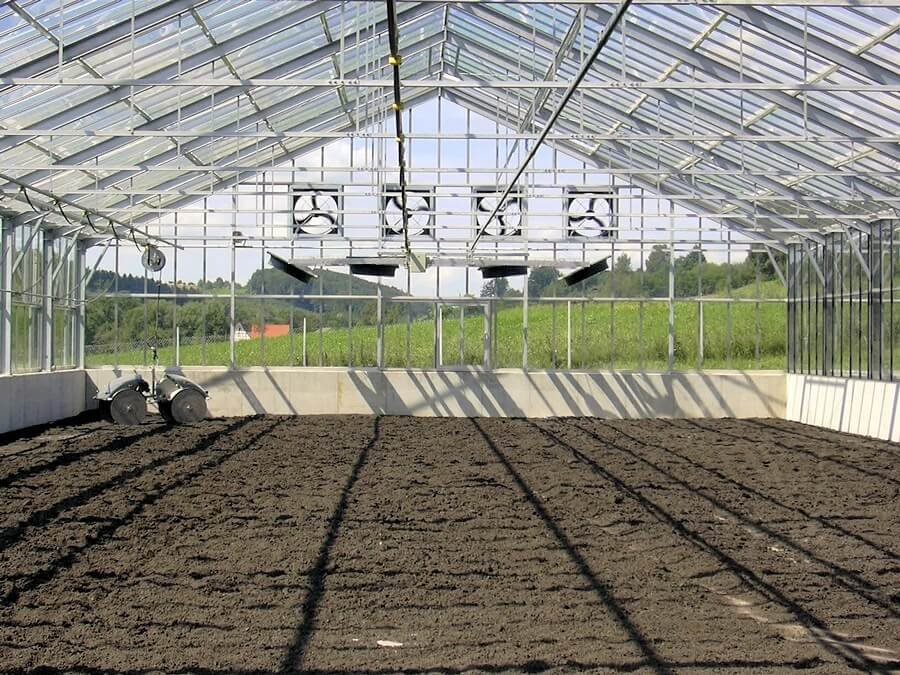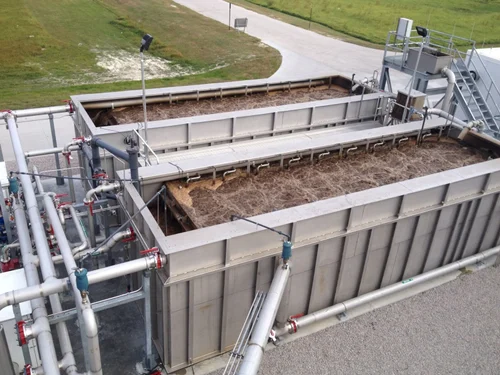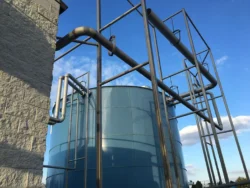Composting in Wastewater Treatment: Enhancing Sustainability Practices

Integrating composting into wastewater treatment offers a sustainable method for waste management, transforming organic waste into valuable compost. The interaction between these two processes is vital for reducing the environmental impact of waste. Composting utilizes natural decomposition to break down organic matter, such as food scraps and sewage sludge, into a nutrient-rich product that can enhance soil health and structure. In the context of wastewater treatment, composting presents a beneficial way to handle biosolids, which are the organic byproducts of sewage treatment.
Implementing composting processes within wastewater management systems requires careful design and operation to ensure environmental compliance and effective treatment of waste materials. Understanding the necessary infrastructure, from aerobic and anaerobic systems to temperature and moisture control, is essential for a successful composting program. It’s a multi-faceted approach involving science, engineering, and economics, facilitating the recovery of resources and promoting a circular economy.
Key Takeaways
- Composting transforms wastewater byproducts into beneficial soil amendments.
- Effective composting in wastewater requires tailored facility design and maintenance.
- This integration supports environmental protection and resource recovery initiatives.
Fundamentals of Composting
Composting is a critical process in managing organic waste, transforming it into a valuable resource. When applied to wastewater treatment, it takes on added dimensions of complexity and utility.
Definition and Concepts
Composting is the aerobic, biological process that breaks down organic materials into a stable, humus-like substance known as compost. In the context of wastewater, it involves the decomposition of organic matter present in the sewage sludge. This sludge is predominantly water but also contains a mix of elements such as nitrogen, phosphorus, and microorganisms.
- Components of Composting: Composting requires a balance of carbon-rich materials (like wood chips) and nitrogen-rich materials (like food scraps).
- Conditions for Composting: The process is carried out under controlled aerobic conditions where moisture, oxygen, temperature, and pH are managed to enhance microorganism activity.
- End Product: The outcome is compost, which can be used as a soil amendment, enriching it and improving structure.
Benefits of Composting in Wastewater
Composting in wastewater presents various environmental and economic advantages:
- Waste Reduction: It significantly reduces the volume of waste, which in turn decreases the burden on landfills and incineration facilities.
- Resource Recovery: The process converts waste into a useful product that can enhance soil health and fertility.
- Pollution Mitigation: It can reduce odors and potentially harmful emissions in comparison to raw sewage sludge.
- Sustainable Practice: Composting facilitates the recycling of organic waste, contributing to a circular economy approach in waste management.
These benefits underscore the importance of composting in wastewater treatment not only as a waste management strategy but also as a sustainable practice promoting environmental stewardship.
Wastewater Treatment Processes
Wastewater treatment involves several crucial stages aimed at reducing pollutants to levels safe for discharge or reuse. Each phase targets specific contaminants through a series of well-coordinated processes.
Preliminary and Primary Treatment
Preliminary treatment is the first line of defense in wastewater management. It employs physical processes to remove large solids and inorganic materials from wastewater. This includes:
- Screening: To intercept large objects like sticks, rags, and other debris.
- Grit removal: To eliminate sand, small stones, and grit, preventing damage to downstream equipment.
In primary treatment, wastewater flows into large basins or tanks, allowing solids to settle at the bottom while oils and lighter materials float to the top, which can then be skimmed off.
Secondary and Advanced Treatment
Secondary treatment involves biological processes that break down organic matter. This typically includes:
- Activated Sludge: Aeration tanks that introduce air to promote the growth of bacteria and other microorganisms to digest organic material.
- Biofilm Systems: Fixed films, like rotating biological contactors, which use microorganisms attached to surfaces to absorb and digest the organic matter.
In advanced treatment, further steps are taken to address pollutants that secondary treatment doesn’t fully eliminate, such as nitrogen and phosphorus. Techniques may include:
- Membrane filtration: Utilizing micro or ultra-filtration to separate particles at the molecular level.
- Disinfection: Often with chlorine or ultraviolet light to kill pathogens before the treated water is released or reclaimed.
Composting Methods
Composting is a sustainable approach to treating organic waste, including that originating from wastewater. It encompasses strategies such as aerobic composting and anaerobic digestion, each employing distinct processes to stabilize waste, mitigate pollution, and reclaim resources.
Aerobic Composting
Aerobic composting involves the breakdown of organic matter in the presence of oxygen. Microorganisms, including bacteria and fungi, metabolize the waste, producing carbon dioxide, water, and heat in the process. This method is well-suited for composting the sludge generated from wastewater treatment because it drastically reduces pathogens and converts the material into a nutrient-rich soil amendment. It typically requires careful control of temperature, moisture, and aeration to maintain optimal conditions for the microorganisms. Key factors include:
- Temperature: Should be monitored to stay within 55-65°C to effectively kill pathogens.
- Moisture: Content is maintained around 50-60% for microorganism activity.
- Aeration: Regular turning or forced air to supply oxygen uniformly.
Anaerobic Digestion
Contrary to aerobic composting, anaerobic digestion occurs in the absence of oxygen. This process is facilitated by a consortium of microorganisms that decompose organic matter, releasing methane and carbon dioxide as primary by-products. Anaerobic digestion is particularly beneficial in wastewater treatment since it can reduce the volume of waste, decrease greenhouse gas emissions if the methane is captured, and produce biogas that can be utilized as a renewable energy source. The main stages include hydrolysis, acidogenesis, acetogenesis, and methanogenesis. Essential considerations are:
- Retention Time: It can vary from days to months, depending on system design and waste composition.
- Temperature: Mesophilic (around 30-40°C) or thermophilic (around 50-60°C) conditions are maintained to optimize microbial activity.
- Biogas Collection: An integral part of the system to capture methane for energy use.
Design of Composting Facilities
The design of composting facilities, particularly for treating wastewater solids, demands careful consideration of several key factors to ensure efficiency, compliance with regulations, and environmental protection.
Site Selection Criteria
When selecting a site for a composting facility, there are critical environmental and logistical factors to consider:
- Proximity to sensitive land uses: The site should be located away from schools, residential areas, and hospitals to minimize odor impact.
- Accessibility: It must be accessible for incoming waste material and outgoing compost products.
- Topography and Drainage: Areas with flat topography and good drainage are preferred to prevent waterlogging and leachate issues.
- Buffer Zones: Sufficient space must be provided around the site to act as a buffer for noise, odor, and dust.
- Regulatory Compliance: A site must meet all local, state, and federal regulations for composting operations.
Composting System Design Principles
For composting systems that process wastewater solids, the following design principles are paramount:
- Aeration: An adequate oxygen supply is crucial for aerobic decomposition. Forced aeration systems or turning equipment might be employed.
- Moisture Control: Moisture levels should be maintained between 50-60% to support microbial activity without creating leachate.
- Temperature Management: Thermophilic conditions (50-60°C) should be maintained to effectively reduce pathogens.
- C Ratio: The carbon-to-nitrogen ratio must be balanced, typically between 25:1 and 30:1, for optimal composting.
- Biofiltering: When necessary, biofilters can be used to manage the off-gases and minimize odor emissions.
The thoughtful integration of these criteria into the design is essential for the success of composting facilities dealing with wastewater by-products.
Operation and Maintenance
Effective operation and maintenance of composting in wastewater systems are crucial for ensuring efficient process control and meeting environmental compliance. Proper oversight can mitigate issues before they become significant problems, ensuring the longevity and reliability of the system.
Process Monitoring
In composting applications within wastewater treatment, process monitoring is a key component that ensures the composting process operates within the desired parameters. Parameters such as temperature, moisture content, and oxygen levels must be regularly checked and recorded.
- Temperature: It should be maintained between 55°C and 65°C to favor thermophilic microorganisms.
- Moisture: The optimal range is 50% to 60% to facilitate microbial activity without causing anaerobic conditions.
- Oxygen: Aeration systems need to keep oxygen levels sufficient to support aerobic decomposition.
Troubleshooting Common Issues
When operational problems arise, troubleshooting common issues is essential to maintain compost quality and process efficiency.
- Odor Control: If there are offensive odors, it may indicate anaerobic conditions, requiring adjustment of moisture or aeration rates.
- Temperature Fluctuations: Abnormal temperatures could suggest issues with the compost’s microbial activity. Adding more greens (nitrogen-rich materials) or browns (carbon-rich materials) can help stabilize temperatures.
By keeping a vigilant eye on these aspects and addressing issues promptly, the composting process in wastewater treatment can be effectively managed and maintained.
Regulations and Environmental Impact
Composting is a valuable process in managing wastewater by converting organic matter into stable soil amendments while complying with regulatory standards. It serves as a sustainable practice with positive environmental impacts when implemented correctly.
Compliance with Standards
Regulations for composting in wastewater involve adhering to guidelines that protect both human health and the environment. Federal and state agencies, such as the U.S. Environmental Protection Agency, provide frameworks such as the Resource Conservation and Recovery Act (RCRA) that govern the safe handling and processing of wastewater sludge to minimize environmental risks. Entities engaged in composting must regularly monitor and report on:
- Pathogen levels
- Heavy metal concentrations
- Emission controls
Permitting requirements and regular inspections ensure that facilities comply with these standards to prevent environmental contamination and safeguard public health.
Sustainable Practices and Impacts
The sustainable impact of composting in wastewater is multifaceted. It includes:
- Reduced landfill use: By diverting organic waste from landfills, composting helps decrease methane emissions.
- Soil health improvement: The resultant compost adds vital nutrients to the soil, enhancing its quality and fertility for agriculture and landscaping.
- Water conservation: Compost can retain water, leading to reduced irrigation needs and conservation of water resources.
Properly managed composting operations turn potential pollutants into beneficial products and contribute to circular economy principles, proving it to be an environmentally sound method for handling organic waste from wastewater streams.
Case Studies and Real-world Applications
In exploring the integration of composting processes within wastewater treatment, several municipalities and industries have adopted innovative approaches. These real-world applications showcase the potential of composting to enhance sustainability and reduce waste.
Municipal Wastewater Treatment
San Francisco sets a pioneering example with its progressive waste management programs. The city’s approach to composting in wastewater treatment showcases ambitious efforts to achieve zero waste. In their case study, composting plays a crucial role in diverting organic waste from landfills and treating it with wastewater biosolids to produce nutrient-rich compost used in agriculture and landscaping.
Key Features:
- Diversion Goal: Aimed for 75% by 2010; achieved over 80% diversion rate.
- Use of Compost: Beneficially used in local agriculture, reducing the need for chemical fertilizers.
Industrial Wastewater Examples
Industries, particularly those involving food production, are significant contributors to wastewater generation. An excellent case study here involves food waste management, where companies focus on reducing the amount of waste entering wastewater streams by composting food scraps and other organic waste.
Strategies Implemented:
- Pre-Composting: Reducing food waste volume before entering the wastewater stream.
- Post-Composting: Utilizing wastewater treatment byproducts such as sludge as compost materials, transforming waste into an asset.
By analyzing these case studies, the benefits of incorporating composting in wastewater management come to the fore, revealing effective strategies to reduce environmental impact while recovering valuable resources.
Innovations and Future Trends
Advancements in composting applied to wastewater treatment are leading to more efficient systems and environmentally friendly solutions. Innovations aim to enhance the sustainability of wastewater management while maintaining a balance with economic feasibility.
Emerging Technologies
- Anaerobic Digestion Enhancements: New technologies in anaerobic digestion are improving the conversion of organic waste into biogas, a renewable energy source. Modern digesters are more efficient and have a smaller footprint, making composting of wastewater solids a more viable option.
- Nutrient Recovery: Innovations include systems that enable the recovery of nutrients such as nitrogen and phosphorus from wastewater streams. These recovered compounds can then be used as fertilizers, closing the loop on waste and resources.
Research and Development
- Composting Optimization: Through ongoing research, scientists are developing optimized composting methods that integrate with wastewater treatment processes. This research focuses on parameters such as temperature, aeration, and microbial diversity to maximize decomposition rates and minimize odor.
- Pathogen Reduction: Research is also targeting the reduction of pathogens in the composting process to ensure that the resulting biosolids are safe for use in agriculture. New methods involve a combination of heat treatment and microbial competition to neutralize potentially harmful organisms.
Frequently Asked Questions
How does the composting process integrate with wastewater treatment methodologies?
Composting can enhance wastewater treatment by converting biosolids, a byproduct of the wastewater process, into a valuable organic resource. This method both diverts waste from landfills and can be used to improve soil health and structure.
In what ways does onsite composting differ from other composting methods?
Onsite composting is unique in that it processes waste materials at or near the point of generation. This minimizes the need for transportation and can reduce greenhouse gas emissions associated with waste management. Onsite systems tend to be smaller in scale but require more active management than centralized facilities.
What guidance does the EPA provide regarding composting practices in waste management?
The U.S. Environmental Protection Agency provides comprehensive guidelines on composting practices within waste management. Their recommendations support the reduction of environmental impacts and the safe, effective management of organic waste streams.


